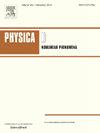Effect of dispersal-induced death in predator–prey metapopulation system with bistable local dynamics
IF 2.7
3区 数学
Q1 MATHEMATICS, APPLIED
引用次数: 0
Abstract
Metapopulation survivability largely depends on the efficient spatial movement of dispersing populations. This study investigates the predator–prey metapopulation model, where the patches are connected by weighted mean-field coupling, capturing species loss due to inefficient dispersal, along with bistability in the local system. Using a semi-analytical approach, it dissects the dynamics of individual patch system (IPS) and homogeneous patch system (HPS), a limiting case of the metapopulation with a homogeneous population distribution. Though HPS can capture a holistic metapopulation dynamic, including persistence and extinction, it fails to differentiate multi-clustered states arising from low dispersal rates and the initial value-dependent behaviours. Our simulation results uncover various emergent metapopulation dynamics, like homogeneous steady states (HSS), global synchrony, multi-cluster and chimera states. It shows that the metapopulation exhibits amplitude death (AD) and oscillation death (OD) based on the dispersal rate, efficiency, and initial active/inactive patch numbers. Moreover, the study formulates a distance-dependent dispersal efficiency on a geometrically generated network with asymmetric patch arrangement. Distance-dependent dispersal efficiency increases the occurrence of the OD state in the parametric plane. Understanding these dynamics sheds light on species survivability in metapopulation and underscores the importance of efficient spatial movement.
具有双稳态局部动态的捕食-食饵元种群系统中分散诱导的死亡效应
超种群生存能力在很大程度上取决于分散种群的有效空间移动。本研究研究了捕食者-猎物超种群模型,其中斑块通过加权平均场耦合连接,捕获了由于低效扩散导致的物种损失,以及局部系统的双稳定性。采用半分析方法,分析了个体斑块系统(IPS)和均匀斑块系统(HPS)的动态,这是具有均匀种群分布的元种群的极限情况。虽然HPS可以捕捉整体的元种群动态,包括持久性和灭绝,但它无法区分由低扩散率和初始值依赖行为引起的多聚类状态。我们的模拟结果揭示了各种涌现的超种群动态,如均匀稳态(HSS),全局同步,多集群和嵌合体状态。结果表明,基于扩散速率、效率和初始活跃/非活跃斑块数,元种群表现为振幅死亡(AD)和振荡死亡(OD)。此外,该研究还提出了几何生成的不对称斑块排列网络的距离依赖扩散效率。距离相关的扩散效率增加了参数平面上OD态的发生。了解这些动态有助于揭示物种在超种群中的生存能力,并强调有效的空间运动的重要性。
本文章由计算机程序翻译,如有差异,请以英文原文为准。
求助全文
约1分钟内获得全文
求助全文
来源期刊

Physica D: Nonlinear Phenomena
物理-物理:数学物理
CiteScore
7.30
自引率
7.50%
发文量
213
审稿时长
65 days
期刊介绍:
Physica D (Nonlinear Phenomena) publishes research and review articles reporting on experimental and theoretical works, techniques and ideas that advance the understanding of nonlinear phenomena. Topics encompass wave motion in physical, chemical and biological systems; physical or biological phenomena governed by nonlinear field equations, including hydrodynamics and turbulence; pattern formation and cooperative phenomena; instability, bifurcations, chaos, and space-time disorder; integrable/Hamiltonian systems; asymptotic analysis and, more generally, mathematical methods for nonlinear systems.
 求助内容:
求助内容: 应助结果提醒方式:
应助结果提醒方式:


